Once you decide to alter your diet to healthier levels than you were used to, a pasta maker is typically the first device that people lean towards.
This is because pasta makers give you complete control over the pasta-making process, so you know exactly what ingredients your pasta consists of.
In This Article You Will Learn... What Is A Pasta MakerTypes Of Pasta Guide: What Can A Pasta Maker DoFeatures To Look Out For: How Is A Pasta Maker MadeMaterial UsedPasta Maker Parts: Manual Vs. ElectricManual Pasta Maker: A Brief LookElectric Pasta Makers: A Brief LookMore Pasta OptionsHow Does A Pasta Maker WorkTypes Of Pasta MakersRoll-And-Cut Pasta MakerExtruder Pasta MakerManual & Motor OperatedStep-By-Step On How To Use A Pasta MakerHomemade Pasta Recipe - IngredientsRun-Down: Preparing The DoughRun-Down: Using The Pasta MakerRun-down: Drying ProcessBenefits Of A Pasta MakerOther Uses For A Pasta MakerCrackersCookiesMini Tarts & PiesNoteworthy Pasta Maker ManufacturersPhilipsMarcatoCucinaProKitchenAidAtlasHow To Clean Pasta MakerConclusionWhat Is A Pasta Maker
For those have never heard of a pasta maker, the name is pretty self-explanatory since it is a device that’s meant to be used in the kitchen to help produce pasta from scratch. You might also know a pasta maker from its other name- pasta machine.
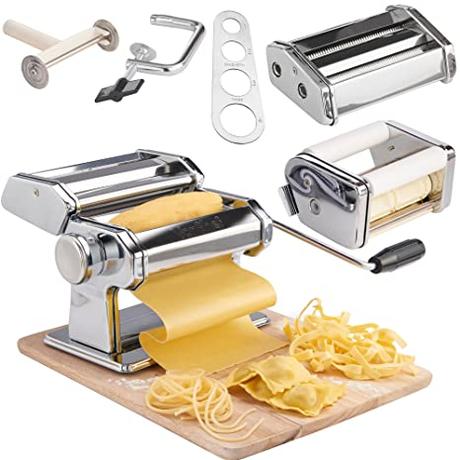
If you’re toying with the idea of buying a standard pasta maker, you’ll most likely have to bolt it on your kitchen countertop to be able to properly roll out fresh sheets of pasta and other dough based food.
You’ll need to go to a kitchen supply store that specializes in Italian cuisine for a top-notch pasta maker, but you can also go to online vendors for more options and better deals. In fact, pasta makers available for purchase online typically offer more variety as to the types of pasta it can make than models you’ll find in stores.
Types Of Pasta Guide: What Can A Pasta Maker Do
Depending on the type of pasta as well as the shape you want to make from scratch, it’s advised to choose a pasta maker that can accommodate to your culinary needs.
A majority of pasta makers are guaranteed to make noodle-like pasta shapes, which comes in handy if a lot of your pasta dishes are noodle-based. Pasta makers come with the proper adjustments that allow a chef favorite such as spaghetti to become a reality.
Pasta makers can also make noodles that more circular and thinner than spaghetti, which include angel hair and linguine pasta.
Keep in mind that certain pasta makers come with attachments that function to broaden the types of pasta shapes you can make, which means you don’t have to limit yourself to cooking only noodle-like pasta dishes.
For instance, specialized pasta makers give you the option to make lasagna, tagliatelle, fettuccine, and other thicker types of pasta which is impossible for a standard pasta maker to achieve.
Features To Look Out For: How Is A Pasta Maker Made
For those who want a worthy pasta maker that’ll prove to be a long term investment, you need to understand the production involved behind high-quality pasta makers.
Material Used
Depending on how much you want to spend on a pasta maker, you could go the inexpensive route and choose a plastic model, but on the other hand, if money is not an issue you should go for a metal pasta maker.
The material utilized dictates the strength of the pasta maker, which directly affects its thickness settings. Time and time again, metal ranks superior to plastic for strength, so metal will provide force and pressure to make pasta of various thickness levels without an issue.
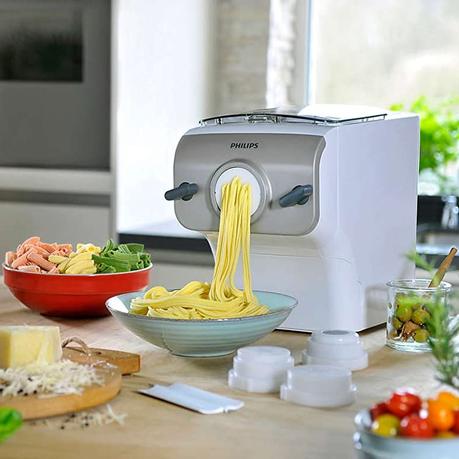
High-grade metal pasta makers will either consist of stainless steel or chrome plated steel, whose main differentiating feature is the maintenance required on your part. The metal that requires meticulous care would be chrome plated steel since it’s not rust resistant.
Fortunately, stainless steel pasta makers are resistant to rust, which means there’s not as much cleaning required as chrome plated steel pasta makers.
When it comes to choosing the material that ensures a long-lasting pasta maker, metal pasta makers are sturdier and more durable than the alternative- plastic pasta makers.
Pasta Maker Parts: Manual Vs. Electric
Other than choosing the material of a pasta maker, the next important feature to specify would be the primary power source that permits the device to function. Your two options consist of either an electric pasta maker or a manual pasta maker, with one being easier to use than the other.
Manual Pasta Maker: A Brief Look
You may have already guessed it based on its name, but a manual pasta maker requires you to physically use your hands to turn the necessary handles that function to flatten up the dough to result in homemade pasta.
List Of Parts
- Rollers
- Cutters
-
Manual Handle
- Regulating Knob
Secure Setup
These pasta makers tend to have a basic structure that involves you anchoring its base to your kitchen counter. The supportive base provides the proper conditions to allow you to turn the manual handle, which as a result rotates the two rollers that are responsible for flattening the dough used to make pasta.
Manual Thickness Control
Don't forget about using the regulating knob, which is responsible for giving you control over the distance between the pasta sheet and rollers that determine the thickness of your pasta.
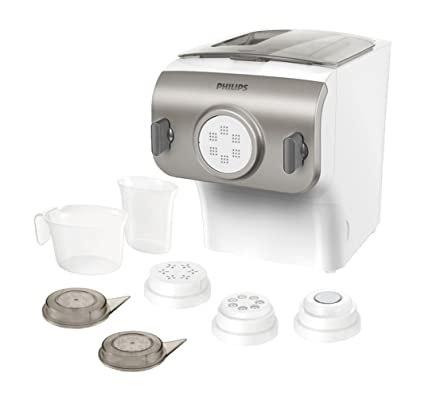
Since you have to set the thickness manually, you run the risk of choosing the incorrect width, which will result in pasta that cannot be used.
Ideal Size
You’ll notice that out of all the various manual pasta maker sizes available, the size that’s most commonly found on people’s countertops will consist of a build that will cater to pasta sheets measuring to be 150 millimeters in length.
Electric Pasta Makers: A Brief Look
Rather than using your hands to operate a manual pasta maker, you can use an electric pasta maker, which efficiently produces some homemade pasta without the need of your hands and energy.
List Of Parts
- Shaping Discs
- Mixing Compartment
- Regulating Knob
- Motor
Saves Times
Electric pasta makers consist of a motor, which is the power source responsible for the device being able to function on its own. In fact, with the help of its motor, the dough you feed into an electric pasta maker will come out as thin sheets of pasta within a matter of seconds.
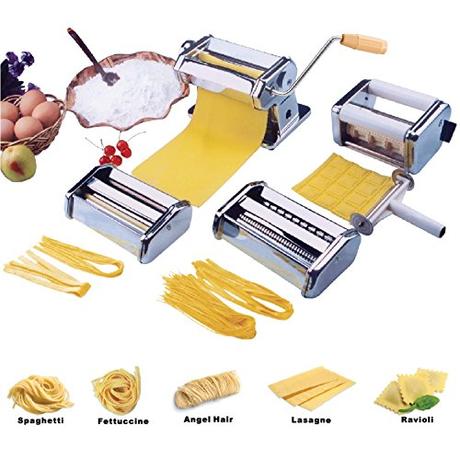
Other than automatically converting dough into pasta, some electric pasta makers come with mixing compartments whose primary function is to knead the dough for you. This means you don't have to move a muscle to make yourself a plate of homemade pasta.
More Pasta Options
Depending entirely on the electric pasta maker brand you decide on; some manufacturers include shaping discs with their electric pasta makers, which give you more room to experiment with different pasta shapes.
Typically, you insert these shaping discs to cover the section of the machine in which the finished pasta comes out to make varying types of pasta that include more than just spaghetti.
In fact, the shaping discs that come with electric pasta makers permit you to make homemade macaroni, ziti, and even more intricate pasta shapes than you knew was possible.
How Does A Pasta Maker Work
If you’re still interested in familiarizing yourself with pasta makers so you can become an expert buyer, you should keep on reading to gain a further understanding of various pasta maker types.
We will build on the pasta maker information that’s already been mentioned above to ensure you know everything there is to know about pasta makers.
Types Of Pasta Makers
Here are the types of pasta makers:
Roll-And-Cut Pasta Maker
Out of all the different kinds of pasta makers available, the one you'll most likely find in someone's kitchen will be a roll-and-cut pasta maker. A roller pasta maker is a household favorite because it's simple to operate and consistently produces restaurant quality pasta.
In fact, a roll-and-cut pasta maker will run the dough you prepared through its rollers, which will continue to flatten as well as lengthen the dough till it comes out in the form of a long thin sheet.
Some of these pasta maker types come with additional attachments whose primary purpose is to cut the already long thin pasta sheets into the desired pasta shape that would otherwise be impossible to achieve using your bare hands. This means you can make more than noodle-like pasta shapes with a roll-and-cut pasta maker.
Extruder Pasta Maker
When you’re dealing with a complicated type of pasta maker, there’s a small chance you’ll see it on someone’s kitchen countertop, but more likely see it in a commercial kitchen.
An extruder pasta maker is the type of pasta maker that is considered to be complicated in build and design, so don’t make the mistake of buying one for your kitchen for in-home use.
In regards to function, extruder pasta makers press your prepared pasta dough through a die that will then create individual pasta pieces. If you’re not satisfied with the pasta length, you can cut off the excess strands till you achieve your desired pasta length.
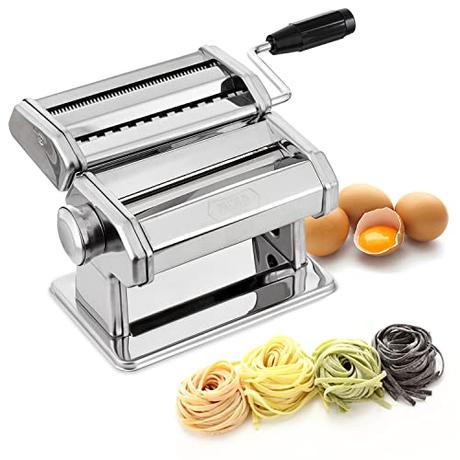
These pasta makers tend to run automatically and require little interference on your end. In fact, once you load all the pasta-making ingredients into an extruder pasta maker, it will mix the ingredients to make the dough.
On top of forming the dough, this type of pasta maker will continue to knead it and force it out of a die to create perfect pieces of tasty pasta.
As a side note, if you’re interested in an extruder pasta maker since it puts less strain on your arms, there are smaller-sized models than the ones used in professional kitchens that will ideally fit in your home’s kitchen.
Manual & Motor Operated
As mentioned earlier, pasta makers can either run manually or electrically, so it’s up to you to determine how much time and energy you want to spend making pasta from scratch.
Manual operated pasta makers typically follow the build of roll-and-cut models since that build comes with a handle you have to physically turn to flatten the dough that makes homemade pasta a reality.
On the other side of the pasta maker spectrum, motor operated pasta makers eliminate the manual labor associated with standard roller pasta makers, which means your hands and arms can finally take a break.
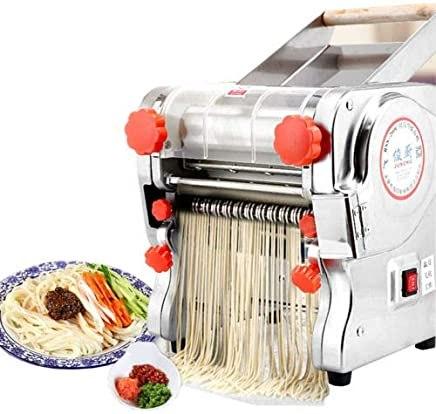
When compared to the roll-and-cut build specifically associated with manually operated pasta makers, you'll notice how motor-operated pasta makers don't adhere to a particular pasta maker model. So don't be surprised to find roller as well as extruder motor operated pasta makers available on the market.
Step-By-Step On How To Use A Pasta Maker
For those who have never used a pasta maker before, you’ll need a couple of practice runs before you can call yourself a pasta making master. Keep reading for a step-by-step guide giving you a run down as to how to use a pasta maker.
Homemade Pasta Recipe - Ingredients
- 2 cups of all-purpose flour
- 2 eggs
- 1 teaspoon salt
- 1 teaspoon olive oil
- 2 Tablespoons water
Run-Down: Preparing The Dough
First, you'll need to mix all the ingredients together either in a designated mixer or manually using a fork. If you have a mixer handy, it's recommended to set it on low speed to properly mix the ingredients.
Once you take 2 minutes to mix the ingredients, you'll have to sprinkle a layer of flour to cover the area in which you'll be kneading the dough. When you knead the dough, you'll want to perform the two following actions-squish, roll, and repeat. Don't worry if the dough isn't entirely smooth since that is normal.
After the dough's been properly kneaded, you should form it into a flat circular shape and continue to wrap it with a plastic wrap fully. To ensure that the gluten fully settles, you have to set the wrapped dough to rest on the counter for 20 minutes or in the refrigerator for two hours.
Run-Down: Using The Pasta Maker
After you’ve completed the dough preparation stage, you’ll begin to use the pasta maker. Once the dough completely settles, you’ll have to unwrap it and sprinkle some flour on both sides to ensure the dough doesn’t stick onto the pasta maker rollers.
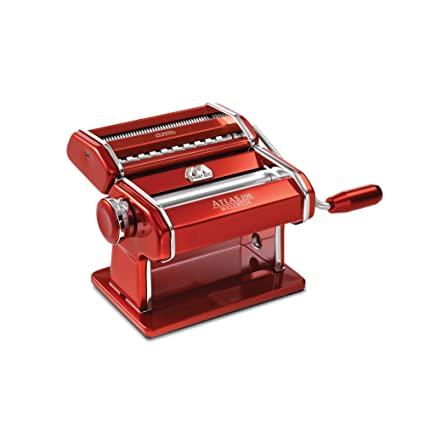
Set the pasta maker rollers to its widest setting and continue to run the flattened dough through the machine. You'll want to keep folding the dough and rolling it through the pasta maker to further knead and smooth it over until the dough has a silky texture to it.
Once the kneading portion is finished, the next step involves stretching the dough. To properly stretch your dough, you’ll have to run it through the pasta rollers that you can adjust. The once wide gap between the two rollers becomes smaller and smaller with each time you run the dough through.
It’ll only take you three to four run throughs until the dough has reached the consistency required to make pasta. Once you have your finished pasta sheet, you can continue to cut it into the pasta shape you desire.
You can use a knife to cut the flat sheets via using your hand, but there are other routes you can take to cut the pasta sheets.
The other route consists of changing the end attachment of the pasta maker to a shaping disc that will cut the pasta sheet to the shape you want. This gives you more pasta options than the alternative of using a knife.
Run-down: Drying Process
Once the pasta is cut to your standards, the tricky part is the drying process since the pasta tends to stick together if done incorrectly. You’ll have to hang the pasta to dry on a unique pasta drying rack and make sure they aren’t touching. You can add cornmeal to avoid having them stick together.
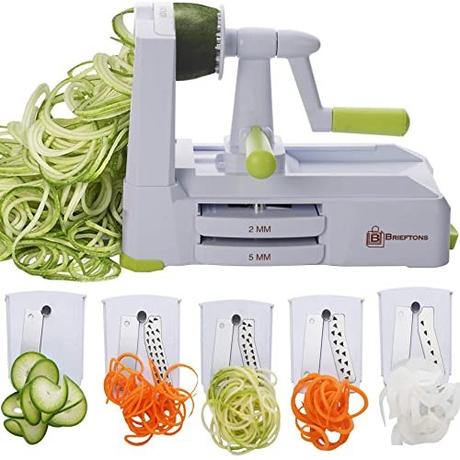
After you set up the drying station, it’ll take your pasta around 20 minutes to fully dry till you can start cooking it.
Benefits Of A Pasta Maker
You can eat freshly made pasta for every meal and, in fact, you'll notice how a pasta maker adds a sharp and delicious flavor to the pasta dish that store bought pasta severely lacks.
You have more control over the ingredients you use to make the pasta, which allows you to create the precise flavors you desire.
For those who want a healthier diet, a pasta maker permits you to avoid consuming the preservatives, and high-fat content typically found inside store bought pasta, so you can eat pasta without labeling it as your cheat meal.
Other Uses For A Pasta Maker
More often than not, people who buy pasta makers end up using it for other cooking and baking-related purposes than just making fresh pasta.
Expanding a pasta makers role in your kitchen guarantees it won't be sitting on your kitchen counter collecting dust since you surely won't be making fresh pasta every day for in-home meals.
If a recipe calls for slightly firm dough that requires being rolled into a thin sheet measuring a maximum length of six inches, you can take out your pasta maker and put it to good use. You can easily imagine the various meals you can make from scratch when you realize that any dough based meal can benefit from a pasta maker.
Crackers
For instance, crackers are thin pieces of dough that have been dried out, so rather than going to a supermarket and buying packages of crackers, you can use your pasta maker to make crackers specific to your dietary needs.
The pasta maker is the only kitchen appliance that will provide a good crispy texture to cracker dough that’s impossible to replicate by using just your hands and a roller.
Cookies
When you're making cookies at home, you're typically using your hands to roll the dough, so it'll most likely stick onto your cutting board, which results in the dough having varying thickness levels. The inconsistent thickness levels translate to cookies that vary from being burnt to being slightly undercooked.
A pasta maker allows you to roll the cookie dough to a consistent thickness that makes the dough a lot more manageable than if you had manually flattened it using your hands.
This makes cutting out cookies using cookie cutters a simple process that guarantees evenly baked cookies that will have your guests believing that you bought them in a bakery.
Mini Tarts & Pies
For those attempting to bake pies meant to be finished in one sitting, a pasta maker is an ideal device that will crank out mini lengths of pie crust dough in a timely fashion. Rolling the pie crust dough in a pasta maker ensures crust of an even thickness that will bake to perfection.
The pasta maker also makes creating decorative pie crust borders an easy feat since you can use a knife to cut out even strips of the consistently rolled crust to make mini tarts that have a braided border.
Noteworthy Pasta Maker Manufacturers
Now that you have a decent background in regards to pasta makers, you should continue reading to familiarize yourself on several
Philips
Philips has roots in the Netherlands and has an international reputation for being a leader in health technology that produces devices whose primary function is to improve your health, which makes sense since it manufactures some of the best-selling pasta makers on the kitchen appliance market.
Marcato
If you’re searching for a brand that specifically only produces pasta makers, you should consider the manufacturer Marcato since it has been making pasta makers in Italy for over 80 years.
When it comes to pasta, everyone knows that the Italians are the pasta masters, so it’s no surprise that Marcato is the pasta maker manufacturer that guarantees professional quality pasta in the comfort of your kitchen.
CucinaPro
CucinaPro is a brand you may have already heard of and is present in your kitchen since it's well-known to produce specialty kitchen appliances that cater to various international cuisines.
You can expect CucinaPro to have a versatile stock of pasta makers at reasonable prices when compared to the other manufacturers mentioned above and below.
KitchenAid
KitchenAid has been around since the early 1900's and made its mark in the kitchen appliance industry when it was the first to release the iconic Stand Mixer that became a staple kitchen device.
Nowadays, KitchenAid produces more than just Stand Mixers, so you can expect to find some KitchenAid pasta makers. In fact, KitchenAid dedicates its time to producing high-grade kitchen devices whose quality craftsmanship is evident and leaves users satisfied with its results.
Atlas
Atlas is a facet of the previously mentioned pasta maker manufacturer, Marcato, so you can expect its pasta makers to adhere to the standards Marcato applies to its devices.
How To Clean Pasta Maker
If your pasta maker consists of chrome plated steel build, you have to adhere to a particular cleaning process that when performed correctly, will ensure your appliance will last you several years before it gives out.
You’ll want to carefully clean the main body of the pasta maker with a solution of soap and water and dry it immediately.
As a side note, make sure not to expose any water to the steel rollers of the pasta maker since they will rust when water makes contact, which will damage the rollers to the point that it will tear your pasta rather than smooth it over.
To properly clean the rollers, you’ll need to turn the pasta machine’s handle and continue to run a pastry brush in a back and forth motion to effectively remove all the pasta dough remains.
Conclusion
Hopefully, you have a good grasp on the intricacies of pasta makers, and you can expertly pick out which one best caters to your culinary requirements.
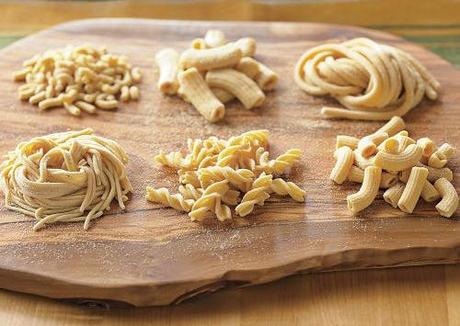
For those who want a more comprehensive look on particular pasta makers, you should check out our buying guide that contains high-grade pasta maker recommendations of varying price ranges.
Resources:
Telegraph
TheKitchn
TheSpruce
HowStuffWorks
MarthaStewart
